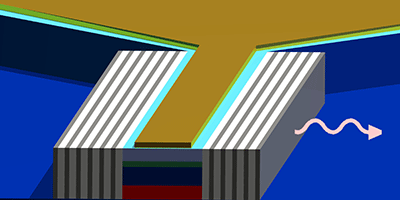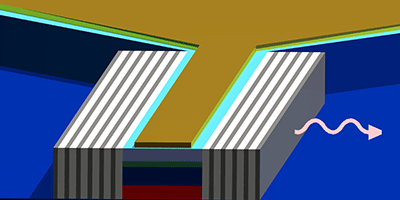A More Practical Polariton Laser
Polariton lasers are more efficient than conventional lasers because they work through spontaneous rather than stimulated emission. In a step towards making these devices more practical, researchers announce in Physical Review Letters the first electrically powered, room-temperature polariton laser. This development may eventually lead to low-power polariton lasers being used as optical switches or compact terahertz radiation sources.
A polariton is a quasiparticle that results from a coupling between a photon and an electron-hole pair (an “exciton”) in a semiconductor material. In 1996, researchers realized that—under certain conditions—polaritons will condense into a single quantum state, from which they will spontaneously emit coherent, monochromatic light (i.e., laser light). In contrast to stimulated lasing, the polariton emitters do not need to be constantly pumped up into excited states (so-called population inversion). As a consequence, polariton lasers begin lasing at a relatively low threshold power.
Experimental realizations of polariton lasers have so far required either low temperatures or a pump laser to create the initial polaritons. Pallab Bhattacharya and his colleagues at the University of Michigan, Ann Arbor, have developed a laser that works at room temperature and is powered by electricity. The device consists of a thin strip of gallium nitride (GaN) semiconductor, sandwiched between stacks of metal oxide mirrors. When electric current enters such a microcavity, it can generate polaritons. But unlike previous designs in which electricity passed through or around the high-resistance mirrors, the team injects current orthogonally to the microcavity’s emitting direction, thus avoiding overheating the device and destroying the lasing. The researchers observed laser light emission at a threshold current density of amps per centimeter squared, which is almost a factor of less than for conventional GaN-based lasers. – Michael Schirber





